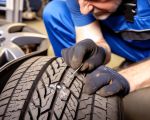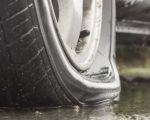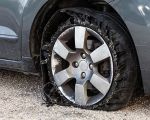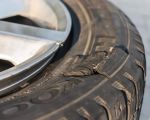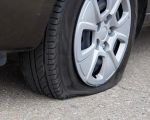Driving on gravel roads is a unique experience that many of us enjoy, whether it's for a road trip or as part of everyday commuting. However, there’s one persistent problem that can make any trip unpleasant: flat tires. Gravel roads, with their uneven surfaces, sharp stones, and unpredictable conditions, pose a significant risk to your vehicle’s tires. Over the years, I've learned a few tried-and-true strategies to prevent flat tires when navigating these challenging terrains. In this guide, I’ll share my knowledge to help you drive more safely and confidently on gravel roads while keeping your tires intact.
1. Choosing the Right Tires for Gravel Roads
The first step in preventing flat tires when driving on gravel is selecting the right kind of tires. Tires that are specifically designed for off-road driving or gravel roads offer better durability and puncture resistance than regular road tires. In my experience, all-terrain or mud-terrain tires are the best choice for gravel roads. These tires are engineered to handle rough and uneven surfaces, reducing the likelihood of sharp rocks causing damage.
Additionally, the tire's tread pattern plays a crucial role. Tires with deeper, more aggressive tread patterns provide better grip on gravel, which helps avoid slipping or skidding. The better the grip, the less likely your tire is to suffer from punctures or blowouts caused by sudden traction loss.
2. Proper Tire Pressure is Crucial
Keeping the right tire pressure is one of the most important aspects of preventing flat tires when driving on gravel roads. Many people don’t realize that driving with too high or too low tire pressure can increase the chances of damaging your tires. If your tire pressure is too high, the tires become stiff, making them more vulnerable to punctures from sharp rocks and other debris on the road. Conversely, if the tire pressure is too low, the tires are more likely to flex and expose the inner parts of the tire to sharp objects.
In my experience, it's important to check your tire pressure regularly and ensure it’s in the optimal range recommended by the manufacturer. For gravel roads, I’ve found that slightly lowering the pressure from the standard highway recommendation can increase the tire's ability to absorb shocks and reduce the chances of a puncture. However, always make sure not to go too low as it could risk the integrity of the tire or cause an imbalance.
3. Avoiding Sharp Rocks and Debris
When driving on gravel roads, one of the best ways to avoid flats is to be proactive in your route planning. Pay attention to the road conditions and try to avoid driving over sharp rocks, large debris, or areas that look like they could have been damaged by heavy vehicles. I always keep my eyes peeled for potential hazards such as exposed rocks, nails, or glass that could puncture a tire.
Sometimes, it’s not possible to avoid all debris, but reducing your speed can significantly help. By slowing down, you give your tires a better chance of reacting to unexpected obstacles. When you do drive over gravel patches, I try to steer carefully around larger rocks or uneven patches that could catch the sidewall of the tire.
4. Maintaining Your Vehicle’s Suspension System
Your car’s suspension system plays a crucial role in absorbing shocks from the road. On gravel roads, the rough surfaces can put a lot of strain on the suspension. If your suspension is weak or damaged, it can lead to uneven tire wear and increase the chances of punctures or blowouts. Regularly checking your suspension system for signs of wear, like squeaking noises or rough handling, can save you a lot of headaches.
When I had an issue with my suspension, I noticed a significant increase in the wear and tear on my tires, especially when driving on uneven gravel. If you notice any issues with your suspension system, it's wise to have it inspected and repaired before heading out onto gravel roads.
5. Driving Technique Matters
How you drive on gravel roads can greatly impact your tire's lifespan. One of the most common mistakes I see is people speeding on gravel, which can lead to tire blowouts and punctures. Gravel roads are unpredictable, and sudden swerves or high-speed maneuvers increase the risk of your tire losing contact with the road, causing unnecessary strain on the rubber. Maintaining a moderate speed and steering smoothly can significantly reduce the stress on your tires.
Another tip I’ve learned is to avoid hard braking. When driving on gravel, you should rely on engine braking and gentle pressure on the brake pedal. Sudden braking can cause flat spots on your tires, increasing the risk of damage, especially when the surface is loose or uneven.
6. Check for Visible Damage Regularly
Before hitting the gravel roads, it’s a good idea to perform a quick inspection of your tires. Look for any visible damage, such as cuts, punctures, or bulges. Even minor damage can worsen quickly when driving over rough surfaces, so catching it early can help prevent a flat tire in the future. I’ve learned the hard way that waiting until the tire gives out is too late, so a proactive approach can save time and money.
7. Keep a Spare Tire and Repair Kit Handy
No matter how careful you are, there’s always a chance you might encounter a flat tire while driving on gravel roads. That’s why I always make sure to have a spare tire, jack, and tire repair kit in my vehicle. In some cases, I’ve been able to patch up a minor puncture on the spot and continue my journey without having to call for help. A tire repair kit typically includes sealant, a tire patch, and a portable air compressor, which can come in handy for temporary fixes until you can reach a more permanent solution.
8. Choose the Right Time to Drive on Gravel Roads
Gravel roads can vary greatly depending on the weather conditions. In my experience, it's best to avoid driving on gravel roads right after heavy rainfall, as wet gravel can become slippery, leading to loss of traction. On the other hand, during very dry conditions, the gravel can become loose and dusty, which increases the risk of damage to your tires. If you can, try to plan your drives when the weather is mild, and the gravel is in better condition.
9. Use Protective Tire Covers for Long-Term Parking
If you’re going to park your vehicle on gravel for an extended period, consider using tire covers to protect them from prolonged exposure to the elements. Gravel roads can cause tires to dry out, crack, or even become weakened over time if exposed to extreme temperatures and UV rays. I’ve found that keeping my tires covered when parked for a long time helps maintain their durability and ensures they last longer, especially during the off-season when I’m not using my vehicle as frequently.
By following these steps, I’ve been able to reduce the likelihood of experiencing flat tires while driving on gravel roads. Prevention is key, and taking care of your tires, maintaining your vehicle, and driving carefully are all crucial components of safe and smooth driving on gravel roads.














